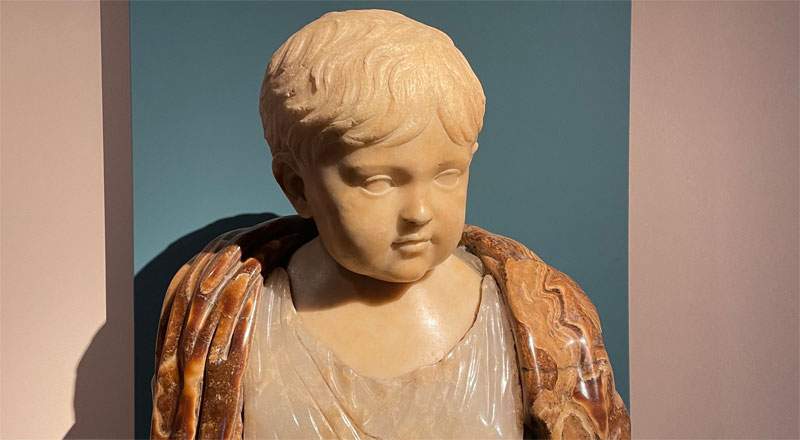Children in ancient Rome: exhibition on childhood in the imperial age at the Uffizi
From November 23, 2021 to April 24, 2022, the Uffizi Galleries in Florence will host an exhibition on a little-addressed topic: children in ancient Rome. Entitled A misura di bambino (Children’s Size ) and curated by Lorenza Camin and Fabrizio Paolucci, the exhibition, billed as the first exhibition on children in ancient Rome, tackles the subject of children’s daily life in the time of the Empire with a survey of more than 30 works, including sculptures of deities as children, ante litteram“action figures,” games and toys from millennia ago to explore themes such as birth, rites of passage to adulthood, schooling, entertainment, the relationship with animals, and fears, all represented in statues, sarcophagi, reliefs and everyday objects such as, indeed, toys.
Among the most significant works are a statue of Mercury with baby Bacchus, restored for the exhibition and returned to the public from the Uffizi Galleries’ storerooms after decades, a rare ivory doll from the 3rd century AD that has never before been exhibited, and a toy gladiator statuette equipped with modular accessories, not unlike today’s action figures. Also of particular value is a selection of tanagrines (a special type of funerary statuettes), from the Hellenistic and Roman periods, which have never been presented to the public and entered the Galleries’ collections following a seizure in an art depository raided by German troops. A focus is also devoted to the often adventurous or difficult childhoods of the gods of the Roman pantheon, such as Hercules or Bacchus: in the reserved section, visitors will be surprised to recognize in chubby little boys the gods of Olympus.
The exhibition, while designed for an adult audience, also offers keys to interpretation and paths designed for the very young. Accompanying the display is in fact a series of didactic apparatuses, such as captions written in a ’child-friendly’ language, comic strips drawn by Stefano Piscitelli and some mp3s made by Carlotta Caruso and Sara Colantonio of the National Roman Museum. In line with museum criteria already experimented within the Galleries, intended to facilitate the inclusion of the youngest(Beato Angelico’s Thebaid, positioned 65 cm high), some works are displayed lower down so that children can look their 2000-year-old peers in the eye. A film, curated by Gianmarco D’Agostino for Advaitafilm Film, concludes the tour and takes visitors, through sounds and images, to a garden of ancient Rome where some children experience moments of their day.
“The exhibition opens on the heels of International Children’s Day, which falls on Nov. 20, and which should not remain an empty celebration,” says Uffizi Director Eike Schmidt. “For the Uffizi it is an opportunity to address an age group that is little considered in art, both as a subject and as an audience. Art is not just something for grown-ups, and this exhibition demonstrates that by putting in place peer involvement that spans centuries of history. The children of Roman antiquity speak to the children of today in the same language.”
“This exhibition is an extraordinary opportunity to bring children to the Museum,” emphasizes curator Fabrizio Paolucci. “The visiting experience, facilitated by the various learning modes proposed, will make them feel part of the narrative and stimulate their curiosity without boring them. With ’Choose your playmate!’, in particular, the young visitors will be able to identify, among the works on display, the child portrait they liked best and which will become the opponent of a challenge to the last nut in one of the playful activities planned at the Boboli Gardens with the arrival of the summer season. Family, tactile and LIS (Italian Sign Language) tours have also been scheduled.”
“The exhibition, the first dedicated to Roman childhood,” explains curator Lorenza Camin, “addresses the most diverse aspects of living ’as a child’ in Ancient Rome, from rites of passage, to school, from games to the relationship with animals. On an occasion like this, works that taken individually manage to be difficult for visitors to understand, become fully appreciable and comprehensible in an organic narrative path. Statuettes, reliefs, busts, sarcophagi and toys will thus be the protagonists of a narrative that will restore voice and body to a fundamental part of ancient Roman society.”
 |
| Children in ancient Rome: exhibition on childhood in the imperial age at the Uffizi |
Warning: the translation into English of the original Italian article was created using automatic tools. We undertake to review all articles, but we do not guarantee the total absence of inaccuracies in the translation due to the program. You can find the original by clicking on the ITA button. If you find any mistake,please contact us.



























